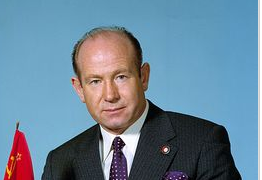Whether it was odd alleyways in a town, or random birds and mushrooms on a hunting trip, he was always lagging behind, appreciating them. One of his pilot-training photos showed him, in full uniform, lying in a clover field to gaze tenderly at a stem of flowering grass. Now he had seen the colours of space. He had prepared for it, he thought, taking a sketch pad and crayons onto Voskhod-2.
不管是鎮子里的小巷,還是狩獵旅行中看到的隨機的鳥兒和蘑菇,列昂諾夫總是會走在大家后面,欣賞它們。 在一張飛行員訓練的照片中,列昂諾夫身穿制服,躺在長著三葉草的田野中,溫柔著凝視著一束花草。現在列昂諾夫看到了太空的顏色。他為此做了準備,他把一個速寫板和蠟筆帶到上升2號飛船。
Yet nothing could have prepared him. There were so many more colours than on Earth, and so much brighter. Onboard he sketched the sunrise, with its astonishing sharp luminescence of red, green and yellow against the black and the blue. When Yuri Gagarin, the first man in space and his best friend from cosmonaut training, the short handsome foil to his tall, fair, bland-faced self, came on the radio during the walk to ask how "Artist" was, he simply said: "I can see so very much."
然而,他卻毫無準備。那里有比地球上多得多的顏色,也比地球上明亮得多。他在船上畫了日出的素描,在黑與藍的襯托下,日出的紅、綠、黃三種顏色發出令人驚異的強烈的光。尤里·加加林是首位進入太空的人類,他是宇航員訓練中列昂諾夫最好的朋友。與高大、白皙、面無表情的列昂諾夫相比,他顯得矮小而英俊。 加加林在電臺上問正在天空行走的列昂諾夫什么是藝術家,他簡單地回答道:“我能看到如此多的東西。”

Undoubtedly he had to mention that blue if, as he hoped, he spoke to Earth as the first man standing on the Moon. He trained hard for that, mostly by using helicopters as mock lunar-landing craft, but the Soviet plans struck him as downright dangerous. In any case, in the space race that consumed the world's two great powers for almost two decades, the Americans nosed past in 1969 with the Apollo 11 landing. He watched it, one of the few Russians allowed to, his heart pounding with anxiety for the crew.
毫無疑問的是,正如他希望的那樣,如果他作為首位登月的人和地球對話,他得提到這個藍色的星球。為此,他進行了艱苦的訓練,主要是使用直升機作為模擬月球登陸太空船,但蘇聯的計劃讓他覺得非常危險。不管怎樣,在這場消耗兩大強國近20年的時間的太空競賽中,1969年,隨著阿波羅11號的著陸,美國人匆匆走過月球。作為被允許觀看的為數不多的幾個俄國人之一,他注視著這艘船,他的心因對船員的擔心而怦怦直跳。
譯文由可可原創,僅供學習交流使用,未經許可請勿轉載。












